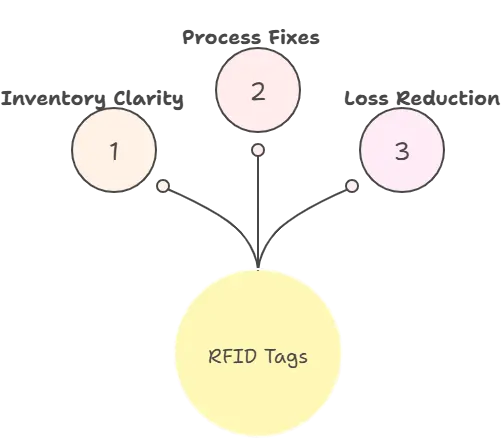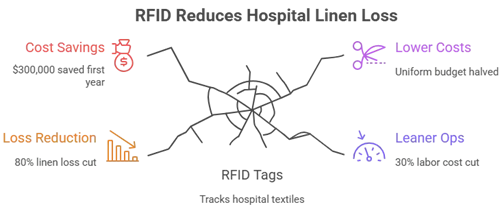
Case Study: How RFID Slashes Hospital Linen Loss Rates from 15% to Below 3%
Custom Your RFID Cards
Is your hospital’s linen budget vanishing into a black hole of unexplained losses? You’re not alone. For decades, healthcare organizations have silently absorbed massive, untraceable linen loss as just part of doing business. Industry data reveals shrinkage rates routinely reach 15–20%, draining nearly $1 billion from U.S. hospital budgets each year. Now, RFID is transforming that reality, by giving linen a tough digital ID, so hospitals can finally see their inventory clearly, fix broken processes, and reduce losses.
Blueprint: Singapore Hospital’s Closed-Loop RFID Transformation
A published academic study from the U.S. National Institutes of Health highlights how Singapore’s Parkway Group hospitals redesigned their entire supply chain with RFID.

- The Challenge: Managing sterile linens and surgical instruments was costly, complicated, and prone to errors.
- The Breakthrough: Instead of simply adding tags, the hospital used RFID to completely revamp their closed-loop process.
- How It Works: Durable RFID laundry tags are attached to every textile and tracked at every step: sterilization, washing, packing, delivery to operating rooms, and return for cleaning.
This real-world case shows RFID isn’t just another tool, it’s the backbone of a modern, auditable, and highly efficient hospital workflow.
Measuring the Impact: RFID’s Real-World ROI
Singapore case isn’t alone. Hospitals and healthcare laundries worldwide report dramatic, proven results by using RFID technology. Here are the numbers:
- Major Loss Reduction: Brazil’s Hospital Israelita Albert Einstein cut linen loss rates from 4% to just 0.8% after attaching RFID tags to 158,000 textiles.
- Immediate Cost Savings: That 80% drop saved $300,000 in the first year alone.
- Lower Procurement Costs: Portugal’s Centro Hospitalar used RFID to uncover internal stockpiling, one employee had 50 uniforms. As a result, the hospital slashed its uniform purchase budget by over half.
- Faster, Leaner Operations: HID Global reports clients cutting labor costs by up to 30%. In Brazil, RFID shrank inventory counts from 72 hours to just 10.

Why RFID Laundry Tags Unlock Real Results
Advanced software delivers real ROI only if your RFID tags perform reliably, everything depends on the tag, which costs just pennies compared to system investments. The system works because the tag can do three things:
Survive Extreme Conditions
Hospital tags live tough lives: they face autoclave sterilization, 60-bar water extraction, and harsh chemicals. Only rugged materials like PPS or medical-grade silicone can stand up to these demands, normal tags will fail, and your whole system stops working.
Enable Safety and Compliance
Infection Control: The system provides an indisputable digital audit log to prove to regulators (like the JCAHO or CDC) that every surgical garment 100% completed its full sterilization cycle before being delivered to an operating room.
Privacy: The tag is anonymous and carries no patient data, making it fully compliant with privacy laws.
➡️ For details on deploying RFID securely, check our Privacy, Security & Compliance Guide.
Deliver Constant, Accurate Tracking
To cut losses, you need tags with top-tier antennas, so they’re readable every time, even on wet or stacked textiles.
Your Hospital’s 4-Step RFID Implementation Plan
You don’t have to overhaul everything at once, success starts with a smart, step-by-step approach.
- Run a Pilot Test
Focus on your biggest pain point first. Is it costly surgical textiles? High-loss items in the ER? Start where RFID will make the biggest difference. - Pick the Right Tag Foundation
The tag is the backbone of your system. Match your hospital’s processes—autoclaves, tunnel washers, etc. to the tag best suited for the job.
➡️ Need help deciding between rugged PPS or flexible Textile tags? Check PPS vs. Textile vs. Silicone Comparison Guide. - Select an Experienced Integrator
Choose a software partner who knows hospital workflows and can seamlessly link tag data to your management system. - Choose a Trusted Tag Manufacturer
We specialize in custom RFID laundry tags tailored to your unique needs, ensuring your foundation is durable and ready for long-term success.
Conclusion: Setting a New Standard for Safety and Sustainability
RFID is more than a cost-saver, but a new benchmark for smart, safe, and sustainable care. When Brazilian hospitals optimized tracking, they cut laundry water use by 12%. In Portugal, slashing uniform purchases also reduced environmental impact, helping meet key ESG goals. Most importantly, RFID’s digital audit trails make patient safety and infection control a certainty, not just a hope.
